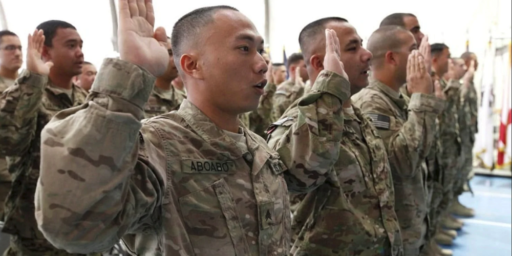The Army We Have
Brian Mockenhaupt has a superb story in Atlantic Monthly about the difficulties of sustaining an Army fighting a war that requires more sophisticated soldiers than ever before during a long war without conscription. It’s subscriber-only and I don’t want to abuse my subscriber privileges too much. This excerpt, though, conveys a good bit:
Yet now, more than at any time since Vietnam, the Army needs strong, quick-thinking, highly disciplined soldiers. Combat units are being sent onto battlefields that are more gray than black-and-white; soldiers on patrol in places like Afghanistan and Iraq must understand something that the Army itself has had a hard time learning: put bluntly, when to shake a hand and when to shoot someone dead. Today’s soldiers must synthesize more information than any American fighters before them, combining their knowledge of tactics with an awareness of the cultural landscape and an appreciation for the strategic implications of their actions.
Turning civilians into soldiers and teaching them to kill has always been difficult work, but these new challenges and demands have made it harder still, so the Army has made sweeping changes in the basic combat training that every recruit must go through. Drawing on the experience of battle-hardened veterans, the Army is incorporating the lessons learned in Iraq and Afghanistan. But at the same time, its overwhelming need for more soldiers puts limits on how tough its training can be. What if the physical and cultural demands of becoming a soldier intimidate potential recruits from signing up, or cause too many to wash out once they join? After all, many of today’s military jobs require more brainpower and technical skill than warrior ethos. (The tooth-to-tail ratio of combat soldiers to support troops has dropped steadily since the Civil War and is now less than 1-to-7.) Is it worthwhile to make a soldier march 20 miles, even though his or her actual job may never call for such a march? The Army’s answer to these questions, for now, is to offer its recruits a less hostile environment that won’t scare off as many people or make them quit: less shouting, less running, more encouragement, more understanding.
Some weak or undertrained soldiers have always gotten through basic training. When they show up at their assigned units, their comrades usually bring them up to speed. But doing so takes time and detracts from a unit’s overall preparedness. And now the Army finds itself facing a double bind: Not only does the new approach to basic training let greater numbers of less-fit soldiers get by; today’s accelerated deployment schedules give units less time for collective training, let alone remedial attention. This winter, for example, two combat brigades had to skip their counterinsurgency and desert training at Fort Irwin, California, in order to deploy to Iraq as part of President Bush’s “surge” strategy. So far, there’s only anecdotal evidence that the changes in basic training are infiltrating more of the weak and the incompetent into the Army’s frontline units. But as the demand for more boots on the ground continues to grow, imposing more pressure on the Army’s ability to recruit, train, and retain personnel, so, too, will questions about the long-term viability and strength of the nation’s all-volunteer force.
I’m optimistic that we can sustain this for quite some time, despite cries of a “broken Army.” (Yesterday, DoD announced that it had exceeded its active component recruiting and retention goals for April.) Clearly, though, we can’t do it forever without making unacceptable trade-offs. (The same release noted a significant shortfall in Reserve Component recruiting and retention.)
It’s not all bad, though. The Army is an incredibly adaptive institution. Even though it can be slow to embrace big changes, it can quickly incorporate new lessons.
In addition to shifting to a kinder and gentler approach, in late 2002, TRADOC pulled together an Army-wide group to study whether recruits were gaining the right skills. The study group asked field commanders what their new soldiers lacked, and it incorporated lessons learned from Afghanistan. Since then, the Army says, the training of recruits has become more directly tuned to combat situations than ever before. In early 2003, training posts started issuing rifles in the first days of basic training. Previously, weapons were stored in locked rooms and drawn out only for trips to shooting ranges and for field exercises. Now, recruits carry their rifles everywhere—to physical training, breakfast, lunch, dinner, and the bathroom—just as they will while deployed. This change has cut down on accidental shootings in Iraq and Afghanistan, Army officials say.
Mockenhaupt, himself a former infantryman, notes that a speech MG John Schofield gave West Point cadets in 1879 has a renewed following:
The discipline which makes the soldiers of a free country reliable in battle is not to be gained by harsh or tyrannical treatment. On the contrary, such treatment is far more likely to destroy than to make an army. It is possible to impart instruction and to give commands in such manner and such a tone of voice to inspire in the soldier no feeling but an intense desire to obey, while the opposite manner and tone of voice cannot fail to excite strong resentment and a desire to disobey. The one mode or the other of dealing with subordinates springs from a corresponding spirit in the breast of the commander. He who feels the respect which is due to others cannot fail to inspire in them regard for himself, while he who feels, and hence manifests, disrespect toward others, especially his inferiors, cannot fail to inspire hatred against himself.
At least as recently as 1984, all West Point plebes had to memorize that passage (I’ve added the last two lines, omitted by Mockenhaupt) under the title “Schofield’s Definition of Discipline.” I rather suspect they’re still learning it. That it has made its way down to Basic Training strikes me as a very good thing. A softer approach does not necessarily mean a weaker soldier.





Greetings,
This quote is quickly becoming and urban myth.
—
This winter, for example, two combat brigades had to skip their counterinsurgency and desert training at Fort Irwin, California, in order to deploy to Iraq as part of President Bush’s “surge†strategy.
—
These Brigades did not skip their COIN training. We took the NTC to Ft Stewart to train their brigades. The NTC moved an entire suite of electronics, the O/C Teams, OPFOR players and Iraqi National Role players to Ft Stewart.
The 07 I have talked with about the Ft Stewart rotation specifically stated that it was better training as it was easier for the OPFOR to put in the IEDs that here in the open desert.
Also, keep in mind, a Brigade ships it’s equipment out here – that takes about 2 weeks to rail the stuff out. And then 2 weeks to rail it back home. 2 of those 4 weeks are soldiers sitting in the Dust Bowl executing the railhead operations. Now, we gave those soldiers 2 weeks back by not shipping them out here to be with their families.
So:
Plt and Sqd Battle Drills training? Check
Bde / Bn Cdr and Staff training? Check
Combat Ready Bde? Check
More time home with family? Check
Regards,
This was a very, very good article. Go buy the issue.
I seem to recall those actual _goals_ being reduced steadily over the last few years, but I’m not sure how to check – anyone got ideas?
Greetings,
Yes, here’s the link
http://www.usarec.army.mil/hq/apa/goals.htm
Regards,
James,
“Clearly, though, we can’t do it forever”. Wow, you have an insane ability to state the obvious. More! More!
legion,
You liberals have no idea what to do when faced with a political paradox, do you?
First, Bush cuts taxes, after the horrible events of 9/11 and during the recession Clinton left us with, and yet tax revenues have INCREASED by close to a trillion dollars! How how is that possible you all must be shouting!!!
And now, that terrible unnecessary war against terrorism! And yet people keep volunteering. They keep your butt safe by killing terrorists everyday in Iraq and Afghanistan. How is that possible! You must all be racking your little liberal brains wondering how.
Christopher,
Checked the deficit recently?
Uh, yea, I have! First it ballooned because of the recession Clinton left us and 9/11, and now it is less than what we spend on the War on Terror because of the great economy Bush has produced.
Good call, legion!
Mike,
Thanks for the info; seems I was mistaken.
Christopher,
Go talk to any economist on the planet whose paycheck isn’t signed by the GOP. And wipe the foam off your chin; it’s unattractive and unpersuasive.
Mike,
Thanks; it appears I was mistaken.
Christopher,
Ask someone who makes less than $100k per year how the economy is; I think you’ll get a different answer than the folks on Bush’s payroll.